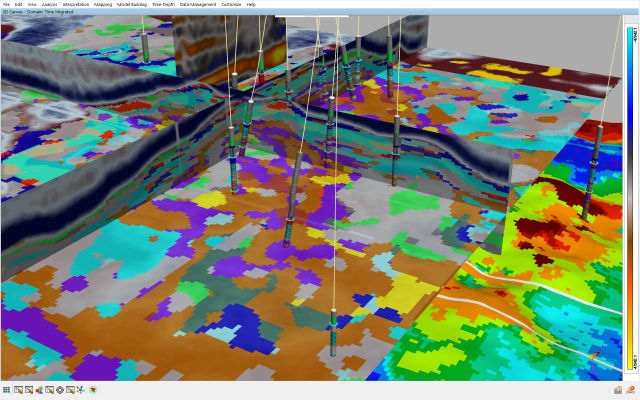
Neural network-based methodology available in current Paradigm software predicts rock type distribution in a complex geologic environment, combined with a display of facies logs along well trajectories. (Source: Paradigm)
Perhaps no industry is more suited to leverage Big Data than the energy industry.
Companies have massive amounts of data at their disposal, but the industry has reached a point where it’s wondering what those data mean and how best to apply it. The value of data is realized only when it is applied properly. As an example of this outside the industry, NBA teams for decades had a wealth of data at their disposal, but they didn’t know what to do with it. More specifically, they didn’t know they could use it. League executives and coaches are analyzing advanced player statistics to build more efficient teams and on-court schemes they believe lead to better performance.
Now, companies are creating highly specialized software that can accurately predict not only how and where a reservoir will produce oil, but how the production of an individual well and how its recovery systems affect the reservoir beneath the other wells on a site.
Paradigm is a software company known for its highly specialized suite of seismic interpretation and modeling tools—tools that are familiar to those sitting on the exploration side of the office but perhaps not as familiar to those sitting in field operations. But that may change with the recent release of Paradigm 17, designed, in part, to give production engineers greater insight into how production is affecting the reservoir in real time.
Through Paradigm 17, companies can tie logs, performing interpretations on complex geology, in addition to historical data gathered through traditional means, into actionable information that shows a more accurate depiction of the reservoir. What’s more, the tool includes a set of coordinated neural networks that collaborate to better predict reservoir conditions, and hence recoverability. The system “learns” to solve an array of challenges rather than just a singular problem.
In the next iteration of this software, the neural network will become self-adapting. “An adaptive neural network would be self-growing its own neurons,” said Indy Chakrabarti, senior vice president of product management and strategy at Paradigm. “It will reshape itself based on the information that it sees. It’s similar to what the brain looks like—how it thinks [and] how information will be generated while it trains itself.”
IBM and Flotek recently announced a global agreement to develop their own cognitive reservoir performance system using IBM’s Watson’s artificial intelligence system—the same system that wiped out Ken Jennings and Brad Rutter on “Jeopardy!” The system uses Watson’s technology to analyze Flotek’s proprietary oilfield chemistry research, oil and gas client-contributed data and publicly reported information from completions and productions to identify new approaches to enhance well performance.
Much like taking a jump shot, you don’t know how the reservoir will pay out until after you take your shot. But analytics are putting operators in the right place on the court to give them the best odds of scoring.
Contact the author at bwalzel@hartenergy.com.
Recommended Reading
Bottlenecks Holding US Back from NatGas, LNG Dominance
2025-03-13 - North America’s natural gas abundance positions the region to be a reliable power supplier. But regulatory factors are holding the industry back from fully tackling the global energy crisis, experts at CERAWeek said.
Arc Resources to Supply Exxon with LNG Offtake from Cedar LNG
2025-03-11 - Exxon Mobil Asia Pacific Pte. Ltd. has agreed to buy 1.5 million tonnes per annum of ARC Resources’ LNG offtake from the Cedar LNG Project when the facility begins commercial operations.
Expand CFO: ‘Durable’ LNG, Not AI, to Drive US NatGas Demand
2025-02-14 - About three-quarters of future U.S. gas demand growth will be fueled by LNG exports, while data centers’ needs will be more muted, according to Expand Energy CFO Mohit Singh.
EIA: NatGas Storage Plunges, Prices Soar
2025-01-16 - Frigid weather and jumping LNG demand have pushed natural gas above $4/MMBtu.
LNG, Data Centers, Winter Freeze Offer Promise for NatGas in ‘25
2025-02-06 - New LNG export capacity and new gas-fired power demand have prices for 2025 gas and beyond much higher than the early 2024 outlook expected. And kicking the year off: a 21-day freeze across the U.S.
Comments
Add new comment
This conversation is moderated according to Hart Energy community rules. Please read the rules before joining the discussion. If you’re experiencing any technical problems, please contact our customer care team.





